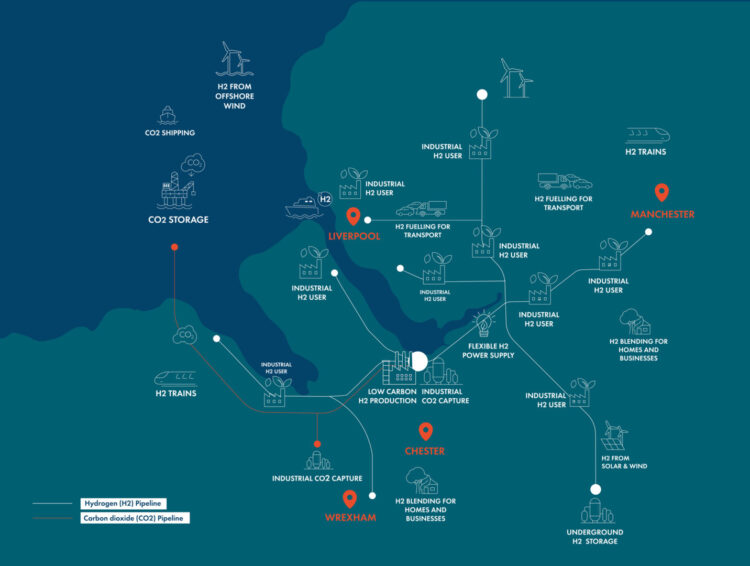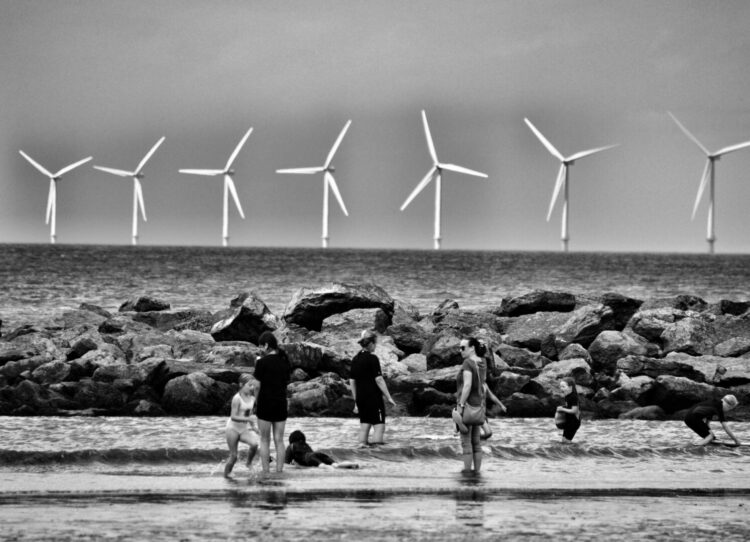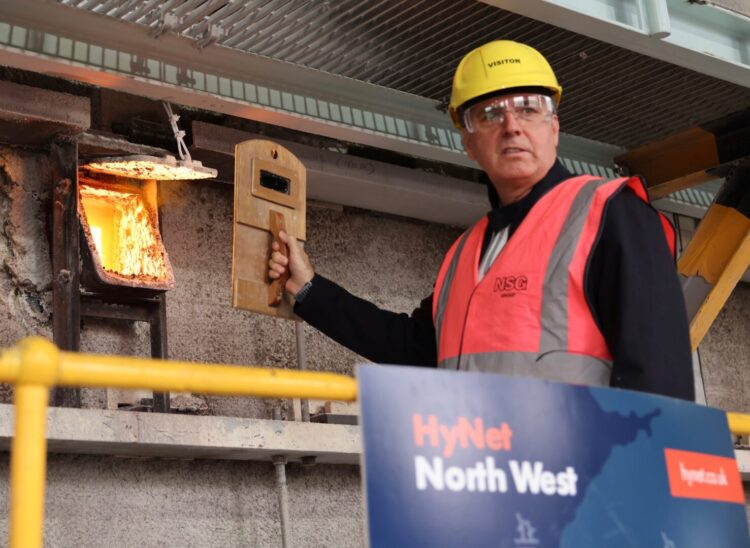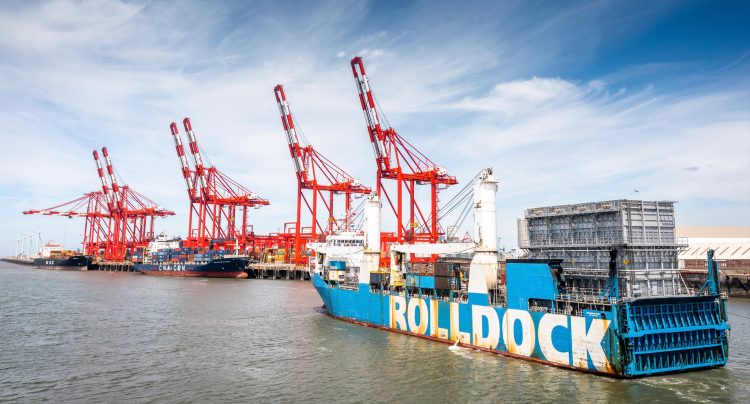Special report: How critical is hydrogen to net zero?
Costing £47bn and offering thousands of jobs, HyNet promises a ‘low-carbon’ hydrogen revolution for Merseyside and the North West – but can it deliver on its mission to help combat climate change? Tony McDonough reports

Backed by billions of pounds from the Government the HyNet consortium is pushing forward to bring a hydrogen revolution to Merseyside and the North West.
Using natural gas, a £1bn production hub at the Stanlow Oil Refinery at Ellesmere Port will pump hydrogen to factories across the North West. It aims to be up and running by the end of 2025.
Among city region manufacturers signed up are carmaker Jaguar Land Rover, glassmaker Pilkington and consumer products giant Unilever.
Critical to the “low carbon” boast of the project is a carbon capture and storage (CCS) operation. This will “capture” the carbon produced by burning the gas. The carbon will then be sent via a pipeline to North Wales. From there it will be pumped out and stored in depleted gas fields under Liverpool Bay.
HyNet aims to start producing hydrogen and capturing the carbon emissions by the end of 2025. Its claimed benefits are:
- Capturing more than 3m tonnes a year of carbon from energy intensive industries.
- Producing 1GW of low carbon hydrogen.
- Supporting the creation of 6,000 new jobs in the first few years.
- Providing businesses and consumers with low carbon products, including chemicals, food and drink, cement, paper and metals.
So how much will this cost? A report into the project by Amion Consulting was commissioned by HyNet partner Progressive Energy on behalf of another partner, Cadent which operates the UK’s gas distribution network.
According to the report, between 2020 and 2050 HyNet will require capital expenditure of £17.7bn and operating expenditure of £29.1bn. It is anticipated most of the operating expenditure will be spent on natural gas. HyNet is a public-private partnership but it is not clear how the costs will be shared. Government is expected to invest a large chunk.
Amion estimates that over a 30-year period, HyNet will lead to the creation of more than 144,000 jobs in the North West and almost 290,000 across the UK. It also predicts £14bn in extra GVA value for the North West and £25.9bn for the UK.
However, this report was compiled well before the Russian invasion of Ukraine in February 2022. Although subject to fluctuation, at the time of writing wholesale gas prices are currently 266% higher than they were a year ago. And many experts believe the price could remain elevated for an indefinite period.

If wholesale prices do remain much higher than they were when the Amion report was published then this potentially changes the economics of the HyNet project. Operating expenditure may exceed the original £29.1bn by a significant margin.
And the price of gas is not the only question mark about the viability of the HyNet venture. Its preferred method of hydrogen production is known as ‘blue hydrogen’. But blue hydrogen is the subject of much debate in academic and industry circles with some claiming its benefits are doubtful.
Is green a better option?
A number of experts believe the UK’s hydrogen strategy should be focused on so-called ‘green hydrogen’. This dispenses with the need for burning gas and instead produces hydrogen using energy from wind or solar via a process called electrolysis.
Abigail Dombey, a chartered engineer and chair of Hydrogen Sussex, told LBN there were already questions over how much blue hydrogen would actually save in terms of carbon emissions. And she added the soaring cost of gas now brought into question its viability.
“All the discussion around hydrogen has been transformed in the last six months,” she said. “With green hydrogen, it is simple. If we produce it from renewable sources then it is zero carbon. Blue hydrogen will never be zero carbon.
“The Government is investing in carbon capture and storage. It is essential for blue hydrogen. However, this process has still not been realised at scale. Even if it were feasible to capture the emissions you will never capture 100% because of the way it is produced.
“There has been a lot of work in the last year about fugitive emissions (leaks from pipelines or tanks) from natural gas as well. There are a lot more emissions upstream than we previously accounted for.
“And as the price of natural gas has increased exponentially then the price of blue hydrogen has increased exponentially as well. Blue hydrogen is never going to be cheaper than natural gas. So it has priced itself out of the market.”
Her view concurs with that of Ben van Beurden, chief executive of UK oil giant Shell. High gas prices, he said, makes blue hydrogen “a little bit difficult”. He added: “Europe will focus very much on making green hydrogen.”
Grey, blue and green
Hydrogen is the most abundant element in the universe. It is an emission-free source of fuel. However, to obtain it we have to separate it from elements in water and fossil fuels. Whichever way you do it, producing hydrogen is an energy-intensive and costly process.
- Grey hydrogen sees the element derived from natural gas via a process called steam methane reforming (SMR). Natural gas mixed with very hot steam. The resultant chemical reaction separates out the hydrogen. However, the carbon emissions are significant and contribute to climate change.
- Blue hydrogen is produced using exactly the same process but, instead of the carbon being released into the atmosphere, it is captured and stored indefinitely. Blue hydrogen is heavily favoured by the UK Government as a bridge to green hydrogen.
- Green hydrogen is the cleanest of all. Through electrolysis water is split into its basic elements – hydrogen and oxygen – using an electric current. The electricity used in the process comes from renewable energy sources such as wind or solar.
One of the main arguments against investing in green hydrogen is its current cost and availability. It is not yet available at scale and would require a significant growth in renewables capacity.
As Abigail Dombey alluded to above, a number of experts are questioning the viability of carbon capture and storage. Despite several attempts elsewhere in the world it has so far not been successfully achieved at the scale HyNet is proposing.
Last year, an academic report published by Robert Howarth, professor of ecology and environmental biology, and Mark Z Jacobson, professor of civil and environmental engineering at Cornell and Stanford in the US was critical of blue hydrogen.
They warned that current CCS technology does not capture enough of the emissions to make it viable. They also warn of leakage of carbon and point to upstream methane fugitive emissions (leaks from pipes etc). Methane is itself a powerful greenhouse gas contributing to climate change.
In conclusion they say once you add in the energy used to fuel the CCS process then the claimed reduction in emissions does not stack up, and may even increase emissions. Click here to read the full report.
HyNet insists blue hydrogen is a temporary solution and that its infrastructure will be built to allow a switch to green hydrogen in the future. But critics of blue hydrogen claim it is a way of prolonging our use of fossil fuels. The involvement of Cadent, as well as oil producer Essar, in HyNet could be seen as backing up that view.
A report in One Earth, which publishes peer-reviewed articles around the environment and sustainability, also questioned the wisdom of blue hydrogen. Written by Jan Rosenow and Richard Lowes it refers to initial excitement over ‘clean coal’ two decades ago. This also pushed the value of CCS but it proved to be a false dawn.
The article says: “Claims by the fossil fuel industry that capturing emissions is feasible and can be done fast need to be carefully examined. There is also a risk of locking in new fossil fuel infrastructure.”
However, the Cornell and Stanford study came in for criticism from David Joffe, head of carbon budgets at the Climate Change Committee, an independent body that advises the UK Government.
On Twitter he claimed the study referred to a scenario where blue hydrogen “is done really badly and without any sensible regulations”. He backed up HyNet and the Government’s view that blue hydrogen was a good “transitional option” to green hydrogen
“If we don’t do that, H2 will be less able to contribute to net zero in the areas where it is important as we won’t have given the demand side time to develop,” he explained.
Blue hydrogen ‘is the only viable way forward’
David Parkin of Progressive Energy is project director for HyNet. In an interview with LBN he claims that hydrogen is essential to the UK’s net zero targets. And he adds that blue hydrogen, followed later on by green, is the only viable way forward.
He explained: “The UK today sources about 80% of its energy from fossil fuels. Around 20% is electricity and half of that is renewable. Everything else is fossil fuels – for homes, factories and transport.
“It is very difficult to transition away from that level of fossil fuel use quickly even with pricing changing. High prices will drive down usage more quickly. But fossil fuels will still be part of the UK’s energy system for the next few decades. It is very difficult to see a way around that.

“So we need to find a way to use fossil fuels responsibly and that is what HyNet gives us. It gives us the opportunity to continue to utilise fossil fuels but do it in a low carbon way. And those fundamentals of HyNet haven’t changed despite the price of gas.
“Yes, the price of natural gas has gone up significantly. But the price our users will pay for hydrogen, due to a Government support mechanism, will still pay the same price as they pay for natural gas today. So there is no greater exposure for users for using hydrogen.
“If you look at the comparison point between blue and green hydrogen, a lot of people will say isn’t the cost of green hydrogen cheaper because of the high cost of gas? But that is not how the UK’s energy system works.
“There is one price point for electricity which is set by the marginal cost of gas. That system potentially is going to change but it will take a long time to bed in. If you can decouple the cost of renewables from the cost of gas, and the cost of gas stays high, the transition point from green to blue will come sooner.”
David adds that it is a lot easier to get investment to scale up hydrogen infrastructure if you go down the blue route.
This view is backed up by a new academic study from Germany. One of its authors, Adrian Odenweller, says green hydrogen capacity would have to grow at a “staggering” rate to meet demand. Click here to read the full report.
“There are two reasons why we start HyNet with blue hydrogen rather than green,” said David. “One is the price point and the other is the scale and availability of renewable electricity for green hydrogen.
“We have identified demand for 4GW of hydrogen in the HyNet region. So if you are going to supply that from electricity you would need about 6GW. If you get that from offshore wind, which operates on about a 50% load factor, then you will need a 12GW wind farm. As of today, there is a total of 12GW of offshore wind capacity in the UK.
“To meet the hydrogen demand in the North West would need the power from every offshore turbine ever built in the UK. It is that challenge of building a hydrogen eco system quickly and then bringing more green hydrogen into the mix.
“And if we can bring green hydrogen in quickly then great but the pipelines, the end use conversion, the storage system doesn’t care if it’s blue or green – it’s just hydrogen
“Progressive Energy is small, it is independent and we are a clean energy product developer. We conceived HyNet a few years ago because we think it is the right thing to do and we do not push any particular technology.
“We are as equally happy for green hydrogen to connect in than we are for blue. And we are progressing a portfolio of green hydrogen projects to feed into HyNet.
“However, it is very difficult to see a route to net zero by 2050 without fossil fuels being used for much of that period. Blue hydrogen is a way of using fossil fuels responsibly. It is about the sheer volume of hydrocarbons that we use today. It is a scale issue.
“When we first started HyNet we might have thought the investment window was 20, 30, 40 years. I think that window is tightening. With the building of renewables accelerating and the cost of electrolysers coming down I do think we will see more green more quickly.
“But that does not stop you starting with blue hydrogen at scale. Vertex Hydrogen is looking to build 1GW of hydrogen in the first instance, that is 1,000MW. A large green hydrogen project in the North West is probably 20-30MW.
“So what the blue hydrogen does is it allows you to make the investment decision in the pipeline. You would need an awful lot of green hydrogen projects before you had sufficient confidence to build out the rest of your ecosystem.
“Blue hydrogen facilitates the infrastructure which you can then plug green hydrogen into. We will build out blue hydrogen at scale over a period of time. But if we did not have at least some green hydrogen on the HyNet system by the mid to late 2020s then we would have failed. I think it will build up incrementally.”
Will carbon capture work?
It is carbon capture and storage (CCS) that has provoked the fiercest debate. CCS is not a new technology. It has been used for decades in areas such as fertiliser production and in oil and gas where captured carbon is injected into depleted fields to produce more oil.
However, in those sectors the focus was less on capturing the carbon to reduce emissions. For HyNet to be viable it will need to aim to capture and store 90% or more of the carbon emissions. Other projects around the world have struggled to achieve that target.
David Parkin claims the UK is “leading the world” in terms of building commercial structures and putting in place a regulatory framework that ensures targets are met. He explained: “Tthe Environment Agency is putting in really strict regulations on permits for these plants. You have to capture a certain percentage or you won’t get get your permits.


“And the Government is putting in really stringent capture requirements. If you don’t capture a certain percentage of the carbon then you don’t get your financial support. It has to be 90%. No investor will invest in a project where they are not confident that threshold will be met.
“Then you have the storage licence from the North Sea Transition Authority. They do years and years of work to make sure you are technically robust on your storage. If you can’t demonstrate that then you don’t get your storage permit.
“There is simply no way we can get to net zero without CCS operating at scale in the UK. The Committee on Climate Change is very clear on that. It is incumbent on all of us in the sector to make it work.
“There is a cement plant in North Wales where we want to do carbon capture for 100% of the emissions on that plant. Nobody has done that it 100% at that scale.
“Energy from a waste plant in Runcorn which has a million tonnes of CO2 a year going up the stack. This is about twice as much as every house in Liverpool. We are pushing the boat out on a number of fronts.”
What can we use hydrogen for?
Another area of debate is how hydrogen is best used. HyNet’s top priority is heavy industrial use. Processes such as steelmaking, which accounts for around 9% of all human emissions, are seen as ideal.
It has already started working with glassmaker Pilkington in St Helens, and consumer products giant Unilever in Wirral, to use hydrogen in their factories. There is also potential for use in transport.
Hydrogen is seen as a poor solution for cars. People can charge their electric cars at home and the batteries are relatively small. This offers an obvious advantage for drivers. However, as vehicles get heavier the equation changes.
It is a much bigger challenge to produce batteries small enough to power buses, lorries, ships and aircraft. This is where hydrogen may have an advantage. Liverpool City Region Mayor Steve Rotherham aims to have a fleet of hydrogen buses on local streets in the next few months.
Cadent, one the partners in HyNet, is running a trial in Whitby, a village in Ellesmere Port. It will see the heating systems of 2,000 homes switch from natural gas to hydrogen. There is a general consensus that heat pumps offer a much more efficient way of heating homes than hydrogen, but Mr Parkin says it is worth seeing how the experiment pans out.
“HyNet is primarily predicated on industrial demand. That is where we will use it first,” he said: “The second use will be in power stations. If the wind doesn’t blow then you have to switch on your gas-fired power stations. Today it is natural gas and in the future it will be hydrogen. We are also looking at using it in heavy transport such as aviation.
READ MORE: £45m hydrogen furnace arrives in the Mersey
“We will also use some hydrogen for blending in the gas distribution network. That is not necessarily Government policy. You can put in up to 20% of hydrogen and reduce the carbon intensity.
“Domestic heat is probably the single biggest challenge in UK energy policy. There are very strong views on this. There is a strong pro-hydrogen lobby and a strong pro-electricity lobby. In reality I think we will end up somewhere in between.

“People will say heat pumps are more efficient than hydrogen and it is hard to argue with the basic physics of that. One unit of electricity from an offshore wind farm into a heat pump you can get three units of heat. If you get that same unit into an electrolyser and put the hydrogen into a pipe and burn it in a boiler, you might get half a unit of heat.
“However, if you are going to do it via electricity then the sheer scale of infrastructure you need is mind-boggling. You need more generation assets, you need more back-up generation for when the wind doesn’t blow.
“You need bigger wires in everyone’s street. But you might only use that a few really cold days a year. So you have poor economic efficiency.
“I think we will end up somewhere in between. If you have regions where you are using hydrogen in industry anyway then you might roll it out in those regions. Or you might see a hybrid heat pump that can use both electricity and hydrogen.
“We won’t know for definite until we conduct more trials. What we are doing in Whitby is demonstrating the viability. It will also come down to what consumers want.”
Another potential use for hydrogen is to provide storage capacity as the UK ramps up its renewable capacity. Although battery storage technology is advancing all the time it remains a challenge at scale. This is where hydrogen has an advantage.
Mr Parkin added: “The storage caverns we are building in Cheshire will store 1.3TW hours of energy. That is about 600 times bigger than the biggest scale utility battery under development in the UK.
“If you are going to do energy storage at scale which we will need in future to mitigate renewables intermittency in future then you do hydrogen storage.
“And we will have the facilities for that. National Grid’s biggest concern in the next few years is keeping the lights on if we have a lot of renewable capacity. Hynet has the capacity to do that.”

